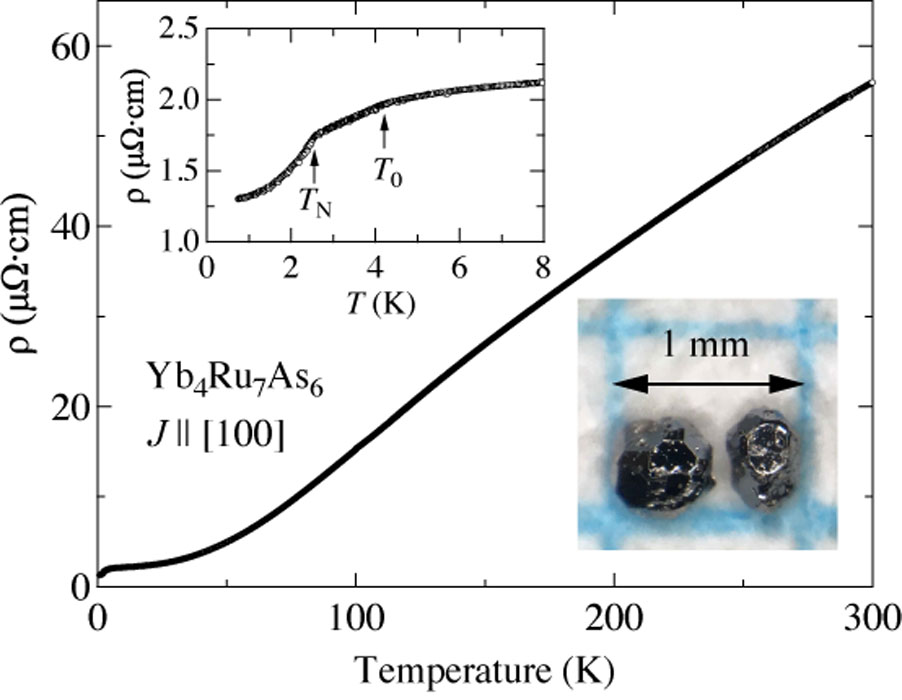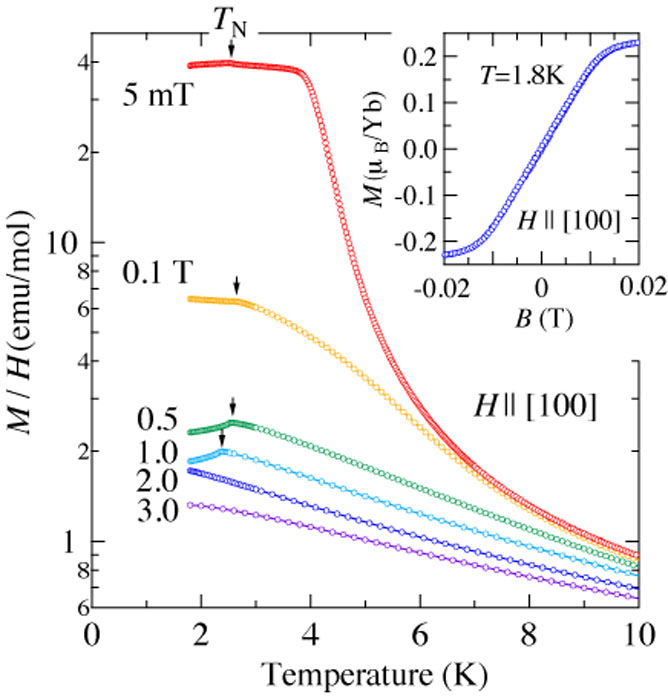Heavy-Fermion Antiferromagnet Yb4Ru7As6 with the U4Re7Si6 Type Cubic Structure
PI of Joint-use project: Y. Hirose
Host lab: Uwatoko Group
Host lab: Uwatoko Group
Yb–T–X (T: transition metal, X: pnictogen) ternary compounds have been studied intensively in terms of novel phenomena in the vicinity of the magnetic quantum critical point (QCP). For example, YbNi4P2 is reported to be close to the ferromagnetic QCP, exhibiting the ferromagnetic transition (FM) at 0.17 K [1]. The field-induced non-Fermi liquid behavior of Yb2Fe12P7 has also attracted attention [2].
To our knowledge, no ternary compound of Yb–Ru–As has been reported. In this study, we have investigated ternary Yb–Ru–As compounds and found a compound Yb4Ru7As6, which crystallizes in the U4Re7Si6-type cubic structure, showing a weak ferromagnetic (FM) behavior below T0~4.0 K and antiferromagnetic (AFM) ordering at TN = 2.5 K with the moderately enhanced electronic specific heat coefficient of 120 Yb-mJ/K2mol [3].
Single crystals of Yb4Ru7As6 were grown by the Bi-flux method, and obtained crystals are shown in the inset of Fig. 1. The crystal structure of Yb4Ru7As6 is determined to be the cubic U4Re7Si6-type structure (No.229, Im3m) using a XtaLAB HyPix-600HE diffractometer. Note that the local symmetry of Yb atom is similar to rare earth metals in skutterudite. Fig. 1 shows the temperature dependence of the electrical resistivity ρ of Yb4Ru7As6 for the current J along the [100] direction. With decreasing temperature, ρ monotonically decreases with a shoulder-like structure below 10 K. At low temperatures, two inflection points at T0~4 K and TN~2.5 K in ρ are observed, as shown in the inset of Fig. 1. The residual resistivity ratio is about 40, indicating a high-quality sample.
Magnetic properties are isotropic reflecting the cubic structure. With decreasing temperature, magnetic susceptibility M/H increases and follows the Curie–Weiss law at temperatures higher than 150 K. The estimated effective magnetic moments are 4.28–4.45 μB/Yb, which is close to the expected value of Yb3+ ionic state: 4.54 μB/Yb. Fig. 2 shows the temperature dependences of M/H for H || [100] below 10 K measured at several magnetic fields. M/H at 5 mT shows a ferromagnetic increment in the temperature range between 6 and 4 K, and a small peak at 2.5 K. Note that no detectable hysteresis loop is observed in magnetization at 1.8 K, as shown in the inset of Fig. 2. With increasing temperature, the peak temperature decreases to 2.25 K at 1.0 T and disappears above 2.0 T, meaning that the peak in M/H corresponds to the AFM transition.
The specific heat C shows an upturn below 7.5 K and λ type sharp peak at 2.5 K, corresponding to the short-range magnetic correlation and/or the Kondo effect, and the long-range magnetic ordering, respectively. In addition, a tiny anomalous behavior is observed at T0~4 K, which corresponds to the temperature where the anomaly in ρ and the occurrence of the FM behavior emerge as mentioned above. It means that T0 can be attributed to a temperature characterizing the FM behavior. TN is shifted to lower temperatures under magnetic fields and seems to disappear at 2.5 T. On the other hand, the tiny anomaly at T0 becomes obscure in the magnetic fields.
The characteristic temperature where the FM behavior in M/H is observed corresponds to the beginning of the short-range ordering as observed in the temperature dependence of C, implying that one of the possibilities of the FM in Yb4Ru7As6 is considered a concomitant phenomenon of the AFM ordering with a canted magnetic moment arrangement from the <100> direction. The canted AFM can be realized in the condition of magnetic interaction and magnetocrystalline anisotropy favoring the non-antiparallel arrangement of magnetic moments. Since there is no inversion symmetry at the center between the nearest neighbor magnetic Yb sites, the Dzyaloshinskii–Moriya interaction can be one of the possible origins of FM behavior, for example. To elucidate the origin of T0, resistivity measurements in magnetic fields are in progress, and further experiments with microscopic probes are needed.
References
- [1] C. Krellner, S. Lausberg, A. Steppke, M. Brando, L. Pedrero, H. Pfau, S. Tencé, H. Rosner, F. Steglich, and C. Geibel, New J. Phys. 13, (2011) 103014.
- [2] R.E. Baumbach, J.J. Hamlin, L. Shu, D.A. Zocco, J.R. O’Brien, P.-C. Ho, and M.B. Maple, Phys. Rev. Lett. 105, 106403 (2010).
- [3] Y. Hirose, K. Arakawa, Y. Kato, Y. Uwatoko, H. Ma, J. Gouchi, F. Honda, and R. Settai, J. Magn. Magn. Mater. 556, 169327 (2022).


